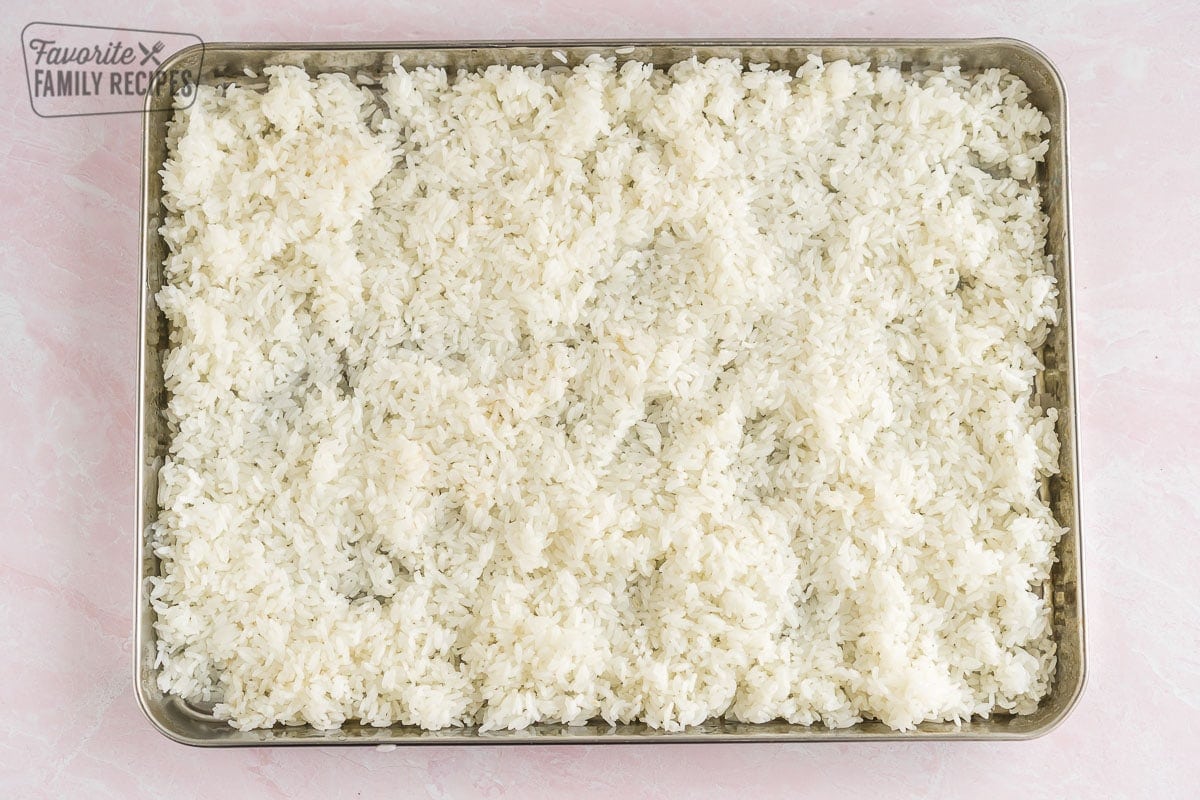We may earn a commission when you click on the affiliate links in this post.
Learn how to make perfect sushi rice at home with easy steps and simple ingredients. Create restaurant-quality sushi rice for all your favorite dishes!

Mastering the Art of Sushi Rice at Home
If you’ve ever wanted to make perfect sushi rice at home, you’re in the right place. I’m here to walk you through every step, from choosing the best ingredients to mastering the seasoning. With a little bit of practice, you’ll be making sushi rice that’s so good, you might just skip the takeout!
I’ve fallen in love with this rice, not just for sushi but for all sorts of dishes. It has a subtle seasoning that enhances the flavors of whatever you pair it with, without overpowering them. Whether I’m making sushi or musubi, I usually have most of the ingredients on hand. Once you’ve got the right ingredients and a few essential tools, you can whip up delicious sushi rice without breaking the bank!
Ingredients for Sushi Rice
You won’t believe how simple it is to make restaurant quality sticky rice at home with just four simple ingredients! Here’s all you need:
- Uncooked Rice – Look for a bag that says “sushi rice” on the label. I have found this at most grocery stores either in the Asian food aisle or with the pasta and rice. Popular brands include Nishiki or Kokuho Rose. If you can’t find sushi rice, Calrose rice is a decent substitute. I’ve used it many times, and while it’s not perfect, it’s a solid alternative.
- Japanese Rice Vinegar – This adds a rich, savory flavor that complements the fish. If you’re in a pinch, apple cider vinegar can work as a tasty substitute.
- Sugar – Just basic granulated sugar.
- Salt – Sea salt, kosher salt, or table salt will all work fine.
- Kombu (dried kelp, optional) – For an even more traditional, umami flavor you can add a 2×2″ square of Kombu to the rice as it is cooking. Kombu is similar to nori (dried seaweed), but thicker and more of an intense flavor. It’s a great way to infuse the rice with even more delicious flavor.

Choosing the Best Rice
The best rice for sushi is, unsurprisingly, called “sushi rice.” It’s a Japanese-style short-grain rice that you can find at Japanese grocery stores or in the Asian food aisle of many supermarkets. If you can’t find it, Calrose rice works in a pinch. Just avoid basmati, jasmine, or any medium or long-grain rice—they’re not sticky enough for sushi. I can usually find the right rice at the grocery store, but if you can’t find it there, check your local Asian market.
Sushi Rice Seasoning
The key to great sushi rice is in the seasoning. Sushi rice has a distinct taste and texture. It should be slightly sweet, tangy, and savory, with a hint of vinegar. I have found actual “sushi vinegar” at the store but I like our seasoning better! You can make sushi vinegar right at home by simply combining rice vinegar, sugar, and salt. It is literally the exact same thing. No need to spend extra for store-bought sushi vinegar.
Some rices have a deeper umami flavor from kombu (dried kelp) being cooked with the rice, but sometimes kombu can be hard to find. In this recipe we make it optional so it is totally up to you if you want to add it or not. As far as texture goes, the rice itself should be tender, yet firm enough to hold its shape when molded into sushi or a ball.

Steps for Making Sushi Rice
- Rinse the Rice: Rinse the rice in a colander or sieve until the water runs clear, then let it drain for an hour. This step is crucial for the right texture, so don’t skip it!
- Cook the Rice: Add rice and water to a rice cooker or large pot. If you are using kombu, add it at this point and allow it to cook with the rice. Cover with a lid and cook according to the recipe instructions. If using an Instant Pot, you can use the “rice” setting or better yet, follow our instructions for Instant Pot Sushi Rice.
- Prepare the Seasoning: While the rice is cooking, heat rice vinegar, sugar, and salt in a small saucepan over medium heat until the sugar dissolves (but don’t let it boil). Remove from heat and let cool to room temperature. You can also add the ingredients to a small bowl and heat it in the microwave. Just remember to allow it to cool to room temp.
- Final Touches: When the rice is finished, spread the cooked rice out onto a baking sheet using a wooden spoon or rice paddle. Sprinkle the vinegar mixture over the rice and mix until all the rice is coated.
- Cool the Rice: Allow to cool on the baking sheet, flipping every once in a while.
- When the rice is completely cooled, it is ready to be made into all kinds of sushi!
Dishes Using Sushi Rice
Sushi rice, also known as shari or sumeshi, is a key component of all kinds of sushi and popular dishes, including:
- Maki (sushi rolls)
- Nigiri
- Hand Rolls
- Chirashi
- Sushi Bowls
- Sushi Bakes
- Sushi Burritos
- Musubi (my kids’ #1 favorite of all time)
You can even use it in poke bowls for a more fragrant base, though traditionally, plain white or brown rice is used.

Reader Reviews
“This came out great! Easiest instructions to follow! It was so fun making our own sushi at home!” – Suzy
“I was very skeptical of the rice cooking technique, but had never had success with any other method and have nothing but time here in quarantine. It is the best rice I have ever made ever! The texture and moisture levels are perfect. I used bottled sweetened sushi vinegar for the win.” – Pat
Frequently Asked Questions
The word sushi literally translates to ‘sour flavor.’ Sushi rice is seasoned with vinegar, sugar, and salt, giving it a subtle sweet and sour flavor.
Sushi rice is made from short-grain Japanese rice, which is stickier than regular rice varieties, helping it hold together well for sushi rolls or nigiri.
Yes, but it’s not perfect. Calrose rice is a medium-grain rice variety that doesn’t have the exact starch characteristics of a traditional Japanese short-grain rice (such as sushi rice) but it’s close enough to get the job done.
Read Next: How to Make Jollof Rice
Recipe Ideas and Inspiration
Now that you’ve mastered the basics, what will you make next? Check out our favorite sushi rice recipes for more inspiration!
California Rolls
Shrimp Tempura Rolls
Spam Musubi
Easy Sushi Bake
How to Make Sushi Rice

Sushi Rice
Video
Ingredients
- 3 cups sushi rice (It should say "sushi rice" right on the bag. Calrose rice works okay if you can't find sushi rice.)
- 3 cups water
- 1 piece Kombu (dried kelp) (2×2" square, optional)
- 1/4 cup Japanese rice vinegar
- 2 Tablespoons sugar
- 1 teaspoon salt
Instructions
- Place the rice into a mixing bowl and cover with cool water. Swirl the rice in the water with your hand, pour off and repeat 2-3 times or until the water is clear. Rinse a few more times. After the rice is rinsed, let the rice drain in a colander or strainer for 1 hour.

- After the rice has drained, put the rice in the rice cooker with the 3 cups of water, cover, and start. If you are using kombu (optional), add it to the rice and water before cooking and allow it to cook along with the rice.If you don't have a rice cooker place rice and water in a heavy saucepan over medium-high heat; bring just to a boil, reduce heat to low and simmer, covered, for 15 minutes. Turn off heat and let rice rest, covered, for 15 additional minutes.

- While rice is cooking, prepare the vinegar mixture. In a small saucepan over medium heat, combine rice vinegar, sugar, and salt. Heat mixture just until the sugar dissolves (do not let it boil). Remove from heat and let cool to room temperature.

- When the rice is done cooking, gently spread out the rice over a cookie sheet. Evenly distribute the cooled vinegar mixture over the rice. You may not need all of the vinegar mixture. Just sprinkle it over the rice until it is lightly spritzed. Gently turn rice over from time to time with rice paddle or wooden spatula so that rice cools evenly. To speed things up, fan the rice each time you turn it over. When rice has cooled to room temperature, it is ready to use for sushi rolls!

Great recipe, thank you!
Looks great. Just the way I make mine.
I find this recipe the best I have tried so far. Previous tried recipes made the rice too vinegary or too wet. This recipe works. Two thumbs up from my son.
For the nutrition facts. For how many servings is that? And is it calculated for cooked rice with vinegar mixture?
I really enjoy the recipe & always use it! Just wanting to watch nutrition facts on my new health journey.
The nutrition facts are based off of a 1 cup serving of the rice and vinegar mixture. Hope this helps!
Can I store leftover rice in the fridge and use the next day?
It dries out a lot when you store it in the fridge, so reheat it with a damp paper towel or other moisture source. It won’t be quite as sticky but it will taste good!
Can I replace Jasmine rice instead of sushi rice?
No, unfortunately, Jasmine rice won’t be sticky enough. Try Calrose rice instead.
Could I substitute maple syrup for sugar?
I think that would be okay!
Maple flavor will not be conductive to over taste and experience. If you seek purer substitute, use rock sugar (you can buy in Asian supermarket).
The measurements are available in the recipe card at the bottom of the post. Hope this helps!
I can’t get the sugar to dissolve
It sounds like you might need to raise the heat a little bit. It can be fairly hot, it just can’t boil.
I ran out of rice vinegar..can I use distilled vinegar instead .. how about the measurement will it change
Yes you can use white vinegar, just add a little bit of sugar and salt to make up for the seasoning of rice vinegar.
Yesterday was the fist time I made sushi at home. I followed this recipe and it was awesome! The best sushi rice I have ever eaten and it was so easy to make and work with.
Just made this using the stove top directions and calrose rice–turned out perfect!
When it said 6 serving does that mean it makes 6 sushi rolls? If not how many sushi rolls does this make?
Yes I am able to make 6 sushi rolls out of this much rice.
This was my first time making sushi rice and it turned out absolutely perfectly using your recipe! Thank you so much!
I have Marukan seasoned rice vinegar. According to the label, 1/4 cup would have 20g sugar and 1920 mg salt. This is the equivalent of 1.59 T of sugar and .84 t of salt– so you might not need to add much!
Hello,
I have a questions. I purchased Kikkoman Seasoned rice vinegar for the sushi rice. Do I still need to add the sugar and salt? I’m following your recipe but noticed the vinegar you used isn’t seasoned. Not sure what to do since I’m attempting to make sushi tonight for a birthday dinner.
Thank you,
Delilah
Yes, I would still add the sugar and salt. The seasoning will just add more flavor, but the sugar and salt are important to the texture of the rice. Hope this helps!
I use the Marukan brand of seasoned rice vinegar, and have used others before (just not sure if one was Kikkoman, but they all appear the same).
These are seasoned WITH sugar and salt, so I would not and never have, added any additional sugar/salt. Probably not as good as ‘homemade’ but, works great for me.
I loved this, a lot easier than I thought it would be and was perfect for our homemade sushi night!
We loved this! It came out perfectly.
worked out perfectly, i added a bit less of the rice vinegar/salt/sugar liquid because I didnt want it too sticky and it was great.